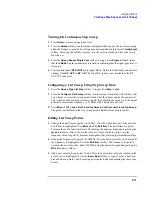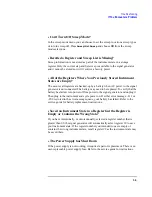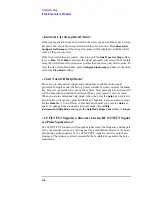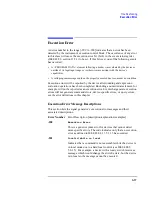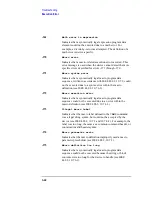
3-11
Troubleshooting
Command Error
Command Error
An error number in the range [-199 to -100] indicates that an IEEE 488.2 syntax
error has been detected by the instrument’s parser. The occurrence of any error in
this class will cause the command error bit (bit 5) in the event status register
(IEEE 488.2, section 11.5.1) to be set. If this bit is set, one of the following events
has occurred:
•
An IEEE 488.2 syntax error has been detected by the parser. That is, a control-to-device
message was received which is in violation of the IEEE 488.2 standard. Possible
violations include a data element which violates device listening formats or whose type
is unacceptable to the device.
•
An unrecognized header was received. Unrecognized headers include incorrect
device-specific headers and incorrect or unimplemented IEEE 488.2 common
commands.
Events that generate command errors will not generate execution errors,
device-specific errors, or query errors; see the error definitions in this chapter.
Command Error Message Descriptions
This section lists the signal generator’s command error messages and their
associated descriptions.
Error Number Error Description [description/explanation/examples]
-100
Command error
This is a generic syntax error for devices that cannot detect
more specific errors. The code indicates only that a command
error as defined in IEE 488.2, 11.5.1.1.4 has occurred.
-101
Invalid character
A syntactic command contains a character which is invalid for
that type. For example, a header containing an ampersand,
SETUP&. This error might be used in place of error numbers
-114, -121, -141 and some others.
-102
Syntax error
An unrecognized command or data type was encountered. For
example, a string was received when the device does not accept
strings.
Summary of Contents for ESG Series
Page 3: ...ii ...
Page 29: ...1 12 Preparing for Use Verifying Signal Generator Operation ...
Page 43: ...2 14 Using Functions Saving and Recalling an Instrument State ...
Page 95: ...3 52 Troubleshooting HP Sales and Service Offices ...
Page 109: ...4 14 Front and Rear Panel Rear Panel Overview ...
Page 111: ...5 2 Hardkey and Softkey Reference ...
Page 135: ...5 26 Hardkey and Softkey Reference Ampl ...
Page 137: ...5 28 Hardkey and Softkey Reference Amplitude ...
Page 139: ...5 30 Hardkey and Softkey Reference Arrow Keys ...
Page 141: ...5 32 Hardkey and Softkey Reference Display Contrast Keys ...
Page 161: ...5 52 Hardkey and Softkey Reference FM ...
Page 169: ...5 60 Hardkey and Softkey Reference Frequency ...
Page 171: ...5 62 Hardkey and Softkey Reference Help ...
Page 173: ...5 64 Hardkey and Softkey Reference Hold ...
Page 175: ...5 66 Hardkey and Softkey Reference Incr Set ...
Page 195: ...5 86 Hardkey and Softkey Reference LF Out ...
Page 197: ...5 88 Hardkey and Softkey Reference Local ...
Page 199: ...5 90 Hardkey and Softkey Reference Mod On Off ...
Page 200: ...5 91 Hardkey and Softkey Reference Mode Mode This front panel key is reserved for future use ...
Page 201: ...5 92 Hardkey and Softkey Reference Mode ...
Page 203: ...5 94 Hardkey and Softkey Reference Numeric Keypad ...
Page 225: ...5 116 Hardkey and Softkey Reference Power Switch ...
Page 235: ...5 126 Hardkey and Softkey Reference Preset ...
Page 241: ...5 132 Hardkey and Softkey Reference Pulse ...
Page 245: ...5 136 Hardkey and Softkey Reference Recall ...
Page 247: ...5 138 Hardkey and Softkey Reference Return ...
Page 249: ...5 140 Hardkey and Softkey Reference RF On Off ...
Page 255: ...5 146 Hardkey and Softkey Reference Save ...
Page 275: ...5 166 Hardkey and Softkey Reference Sweep List ...
Page 311: ...6 10 Options and Accessories Upgrade and Retrofit Kits ...
Page 312: ...7 1 7 Operation This chapter is reserved for future use ...
Page 313: ...7 2 Operation ...
Page 322: ...8 9 Safety and Regulatory Declaration of Conformity Declaration of Conformity ...
Page 341: ...9 18 Specifications HP ESG Series Signal Generators Specifications ...

